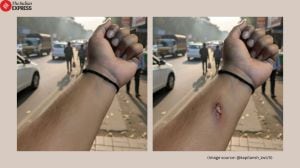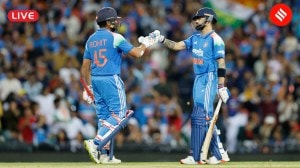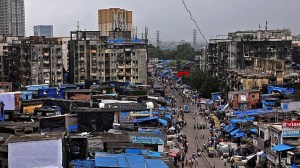Click here to join Express Pune WhatsApp channel and get a curated list of our stories
This Pune student tried to kill a British officer in 1931 — then got a prison term relief and Rs 100 cheque from the latter
Inspired by revolutionaries, Vasudev Balwant Gogate fired two shots at Ernest Hotson, then-acting governor of the Bombay Presidency. Hotson survived and later helped Gogate get an early release from jail.
 Ernest Hotson (left), was fifteen when the incident happened. Gogate (right) was 19-years of age. (Express File Photo)
Ernest Hotson (left), was fifteen when the incident happened. Gogate (right) was 19-years of age. (Express File Photo)On July 22, 1931, the then-acting governor of Bombay Presidency Earnest Hotson visited Fergusson College (FC) with his wife on an official tour.
He walked around the college and then visited the new library of the college, the latest addition to the institute.
When he entered the reading room on the first floor of the Bai Jerabai Wadia Library with Principal GS Mahajani, Lady Hotson headed elsewhere with other hosts. As the party began looking at portraits of the Wadia family which had donated funds for construction of the library, a student sitting at a bench closest to the entrance removed a nickel-plated revolver from his pocket and fired two shots at point-blank range at Hotson, one of which hit Governor Hotson in the chest.
The incident led to great commotion at the campus and made news across the country and in Britain.
 A collage of news coverage of the incident. It was described in the British press as ‘Poona Outrage’. (Express Photo)
A collage of news coverage of the incident. It was described in the British press as ‘Poona Outrage’. (Express Photo)
The boy who shot Hotson was 19-year-old Vasudev Balwant Gogate, an FC student. When he came to study at the college in 1929, the atmosphere in the country was charged with the fire of Mahatma Gandhi’s Civil Disobedience Movement and the trial of Bhagat Singh, Rajguru, and Sukhdev for the Central Assembly bombing. Gogate was inspired by Indian revolutionaries who did not like the patient fight being put by Indian National Congress under Gandhi’s leadership and felt that the British occupation needed to be combatted with force and violence.
Inspired by Savarkar
In an audio interview given in 1970 and available in the Cambridge South Asia Archive, Gogate later said that he was inspired by the autobiography of VD Savarkar, who he had met a year before the incident. He was also moved by the police clampdown imposed in Solapur – including Martial Law – and the atrocities committed by the police against local agitators in Solapur. Many had blamed Hotson for the imposition of Martial Law in Solapur in 1930.
For what he planned to do, Gagate procured two revolvers from Hyderabad where his brother worked as a medical practitioner.
In the interview, he recalled that he had carried Hotson’s photo in his pocket to avoid misidentification on that day as had happened in the case of Khudiram Bose.
“I had read the stories of revolutionaries and I found that some of them had made assaulted the wrong European by mistake. They could not identify them because for us Indians all Europeans are practically alike. I didn’t want to commit such a mistake,” he said.
Gogate’s assumption that the governor would visit the new library was correct. He secured a chair closest to the entrance when the group comprising Hotson, his ADC, principal Mahajani and others entered the reading hall.
 A newspaper report details how students of the Fergusson College shouted slogans against Hotson and also smashed the back window of his car. (Express Photo)
A newspaper report details how students of the Fergusson College shouted slogans against Hotson and also smashed the back window of his car. (Express Photo)
“I closed the book that I was pretending to read, and got up from my seat. I took out my nickel-plated revolver and fired the first shot at point-blank range which struck Sir Earnest Hotson just near the heart. In my mind, I thought that nobody would be able to stop the first shot, and my weapon was so powerful that he would not survive the shot. Then whatever would be my fate was immaterial to me,” he recalled.
Thereupon he was overpowered by Hotson and his Aide-de-Camp and the revolver was taken away. But to his surprise, the gunshot did not have the desired effect on Hotson.
How did Hotson survive?
As per press reports from the time, Hotson was saved by several currency notes and the metal stud of the wallet that he had kept in his chest pocket.
“The first shot, which struck his coat just above the heart, was stopped by the metal stud of his pocketbook, and the next shot missed him. Sir Earnest Hotson sprang forward and, with the assistance of captain Peto, his ADC overpowered the assailant,” reads a news report from the next day.
Gogate, however, suspected that Hotson may have worn a metal jacket which stopped the bullets as he was sure of the ammunition’s potency.
Gogate was charged under section 307 of Indian Penal Code for attempt to murder and carrying arms without a licence. After a week-long trial in September of 1931 in a Pune court, the jury found him guilty, sentencing him to eight years of imprisonment.
Hotson’s intervention
In 1937, as part of the provincial autonomy, a Congress government was elected in Bombay province. At that time, KM Munshi, home minister of Bombay, visited the Belgaum prison where Gogate was lodged. On Munshi’s advise, Gogate wrote a letter to him wherein he said he felt that ‘non-violence was a good policy for India’ and that he wished to study law and pursue the legal profession.
 A photograph of Gogate and a plaque giving a brief history of the incident has been installed at the spot where the shooting happened in the Wadia library. (Express Photo by Atikh Rashid)
A photograph of Gogate and a plaque giving a brief history of the incident has been installed at the spot where the shooting happened in the Wadia library. (Express Photo by Atikh Rashid)
A few days later, Munshi ordered that Gogate be released but the order was blocked by then-governor Brabourne. Munshi then wrote to Hotson who had moved to London after retiring in 1932.
“Mr Munshi wrote to Hotson that he wanted to have me released but Governor Bourbourne wasn’t inclined to it. If Hotson helped in this matter, he would be very happy. Hotson at once went to the secretary of state for India Lord Jetland and told him that he had no objection to my release. Thereupon, Lord Babourne had no alternative but to release me,” Gogate said in the interview.
Following his release, Gogate studied law as he had promised to Munshi, and became a well-known lawyer. He was also involved in right-wing organisations such as Hindu Mahasabha. After entering politics, he became a corporator and later the Mayor of Pune city, and also served on the Maharashtra Legislative Council.
Gogate, became known in the city as ‘Hotson Gogate’ following the incident. A few days after his release from prison, he received a letter from Hotson and a cheque for Rs 100 as a token of goodwill, with wishes that Gogate made a career for himself.
“In his letter, Hotson wrote that he bore no malice towards me and hoped that I too bear no malice towards him. I accepted his cheque and wrote back to him: I accept this cheque as a token of goodwill from you.”
Click here to join Express Pune WhatsApp channel and get a curated list of our stories







